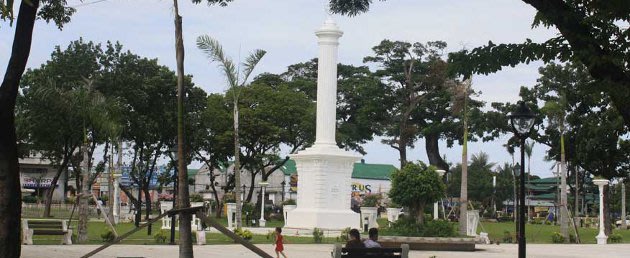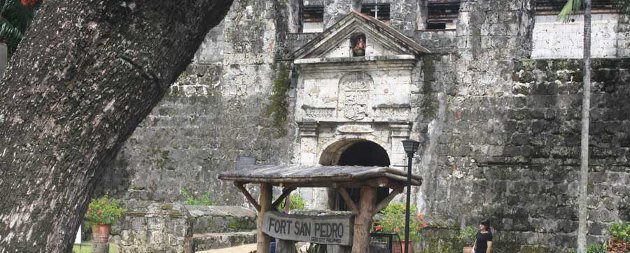Cebuanos reclaim Plaza Independencia
|
The Plaza Independencia in Cebu stands witness to its rich and turbulent past. (Photo by Marlen Limpag)
Cebuanos are starting to frequent once more the Plaza Independencia in Cebu City. The spot has had many functions along the course of Cebu's history: as a military training and parade ground, a premier public park during the reign of Queen Isabella in Spain, and even as a symbol of liberation, after a P16.9 million renovation .
It used to be that people steer clear of the plaza because of its reputation as a haven for thieves, pickpockets, and muggers who take advantage of poorly-lit areas. "Diri man to matug ang mga kawatan sa una (Thieves used to sleep here)," said a City Government employee relaxing in the park.
Bushes and plants allowed to grow wild on many areas of the park also made it a popular place for trysts.
Not anymore. Today, Plaza Independencia stands clean and proud as it did during the childhood of Cebu City Mayor Michael Rama.
Rama said he grew up in the plaza. He has memories of his parents bringing him there when he was a child, and they had allowed him to run around and he had been happy.
The park, at present, is a no-smoking zone and is off limits to vendors. Security personnel patrol the perimeter, and make their rounds on bikes. A sign says alcoholic beverages, indecent acts, bladed weapons, and motorized vehicles are not allowed inside the park.
Concrete pavements neatly divide the plaza into different sections. A paved section that loops along the perimeter may be used for fitness activities like walking or running, said Rama, who added that it will even become longer when he opens the part of the park that was closed in 2007 during the construction of the South Road Properties tunnel.
Rama said he removed the overgrown bushes and plants so the park now has a clear view of Magallanes Street and Malacañang sa Sugbo, adding that the renovation was mostly done except for a few areas that need landscaping.
The park had stood for different things at different times in Cebu's history. It was Plaza de Armas in the 1600s, wrote Lucy Urgello Miller in her book "Glimpses of Old Cebu: Images of the Colonial Era." Spanish soldiers used the square for military training and as a parade ground.
An obelisk at the center of Plaza Independencia is dedicated to Spanish conquistador Miguel Lopez de Legaspi, who established in Cebu the first Spanish settlement in the country. (Photo by Marlen Limpag)
During the reign of Queen Isabella in Spain in 1855, Miller adds in her book, an obelisk was built as a tribute to Spanish conqueror Miguel Lopez de Legazpi, founder of the Spanish settlement in Cebu, at the heart of the plaza. This structure still stands today.
Filipino historian Resil B. Mojares said in a newspaper column in 1994 that it was considered a premier public park during the Spanish era, lined with trees and lighted by kerosene lamps while music from the serenatas (serenade) filled the air.
According to Miller, from Plaza Armas, it became Plaza Mayor when its expansion brought it near properties of the Cathedral of Cebu and then later, in the 1870s, the plaza was renamed Plaza Maria Cristina in honor of Spain's Queen Regent who took over the throne when her husband died.
Historical artifacts — gold death masks, gold earrings, Thai Bluish-green "guan" celadon, jars and earthenware — were unearthed underneath a portion of the plaza in 2008, when civil works for the construction of the South Road Properties (SRP0 tunnel started.
A marker said the park was renamed Plaza Libertad and became a symbol of Cebuano liberation from Spanish rule during the American colonial period. It hosted performances from the municipal band and became a favorite hangout of Cebu's elite.
When the Americans left, it became Plaza Independencia and it is by this name that it's known today.
The plaza also faced threats: squatters encroached near the area in the late 60s and the City Council recommended that it be bulldozed in the 70s.
Newspaper reports in the 1980s said the City Government was able to reclaim the plaza with the help of the private sector and built inside the park a skating rink, children's playground, and food stalls. It was these activities together with the Sunday singing contests courtesy of a radio station that the present renovation ended.
Two friends agreed it was more fun then because the park buzzed with activities. Joggers would start the day followed by those doing tai chi. Then more people would come in and eat snacks or meals in food stalls while others would bring their own and have a picnic. Around 5 p.m., the music would play and the rotunda would be filled with skaters.
Today, a picnic at the plaza is not allowed and activities will need a permit. It's stricter but much, much safer and children can run around without parents having to worry, said a security guard.
Enclosed within Plaza Independencia grounds is Fort San Pedro, the smallest and oldest triangular bastion fort in the Philippines. (Photo by Marlen Limpag)
Rama said the plaza is a "labor of love" and Cebuanos should love the plaza and care for it. "There should be people who love the plaza. If you don't love something, you don't care about it," he added.
Tourists can't afford to miss visiting this historic park that has stood witness to Cebu's past. The plaza is accessible by cab or jeepney from any point of the city. The plaza is bounded by M. J. Cuenco Avenue and Legaspi Extension. Adjacent to the park is the Cebu City Post Office and another important landmark, Fort San Pedro. Several jeepneys from various points in Cebu City also pass by the plaza.
By Narciso Tapia, CebuMD.com
Cebuanos are starting to frequent once more the Plaza Independencia in Cebu City. The spot has had many functions along the course of Cebu's history: as a military training and parade ground, a premier public park during the reign of Queen Isabella in Spain, and even as a symbol of liberation, after a P16.9 million renovation .
It used to be that people steer clear of the plaza because of its reputation as a haven for thieves, pickpockets, and muggers who take advantage of poorly-lit areas. "Diri man to matug ang mga kawatan sa una (Thieves used to sleep here)," said a City Government employee relaxing in the park.
Bushes and plants allowed to grow wild on many areas of the park also made it a popular place for trysts.
Not anymore. Today, Plaza Independencia stands clean and proud as it did during the childhood of Cebu City Mayor Michael Rama.
Rama said he grew up in the plaza. He has memories of his parents bringing him there when he was a child, and they had allowed him to run around and he had been happy.
The park, at present, is a no-smoking zone and is off limits to vendors. Security personnel patrol the perimeter, and make their rounds on bikes. A sign says alcoholic beverages, indecent acts, bladed weapons, and motorized vehicles are not allowed inside the park.
Concrete pavements neatly divide the plaza into different sections. A paved section that loops along the perimeter may be used for fitness activities like walking or running, said Rama, who added that it will even become longer when he opens the part of the park that was closed in 2007 during the construction of the South Road Properties tunnel.
Rama said he removed the overgrown bushes and plants so the park now has a clear view of Magallanes Street and Malacañang sa Sugbo, adding that the renovation was mostly done except for a few areas that need landscaping.
The park had stood for different things at different times in Cebu's history. It was Plaza de Armas in the 1600s, wrote Lucy Urgello Miller in her book "Glimpses of Old Cebu: Images of the Colonial Era." Spanish soldiers used the square for military training and as a parade ground.
An obelisk at the center of Plaza Independencia is dedicated to Spanish conquistador Miguel Lopez de Legaspi, who established in Cebu the first Spanish settlement in the country. (Photo by Marlen Limpag)
During the reign of Queen Isabella in Spain in 1855, Miller adds in her book, an obelisk was built as a tribute to Spanish conqueror Miguel Lopez de Legazpi, founder of the Spanish settlement in Cebu, at the heart of the plaza. This structure still stands today.
Filipino historian Resil B. Mojares said in a newspaper column in 1994 that it was considered a premier public park during the Spanish era, lined with trees and lighted by kerosene lamps while music from the serenatas (serenade) filled the air.
According to Miller, from Plaza Armas, it became Plaza Mayor when its expansion brought it near properties of the Cathedral of Cebu and then later, in the 1870s, the plaza was renamed Plaza Maria Cristina in honor of Spain's Queen Regent who took over the throne when her husband died.
Historical artifacts — gold death masks, gold earrings, Thai Bluish-green "guan" celadon, jars and earthenware — were unearthed underneath a portion of the plaza in 2008, when civil works for the construction of the South Road Properties (SRP0 tunnel started.
A marker said the park was renamed Plaza Libertad and became a symbol of Cebuano liberation from Spanish rule during the American colonial period. It hosted performances from the municipal band and became a favorite hangout of Cebu's elite.
When the Americans left, it became Plaza Independencia and it is by this name that it's known today.
The plaza also faced threats: squatters encroached near the area in the late 60s and the City Council recommended that it be bulldozed in the 70s.
Newspaper reports in the 1980s said the City Government was able to reclaim the plaza with the help of the private sector and built inside the park a skating rink, children's playground, and food stalls. It was these activities together with the Sunday singing contests courtesy of a radio station that the present renovation ended.
Two friends agreed it was more fun then because the park buzzed with activities. Joggers would start the day followed by those doing tai chi. Then more people would come in and eat snacks or meals in food stalls while others would bring their own and have a picnic. Around 5 p.m., the music would play and the rotunda would be filled with skaters.
Today, a picnic at the plaza is not allowed and activities will need a permit. It's stricter but much, much safer and children can run around without parents having to worry, said a security guard.
Enclosed within Plaza Independencia grounds is Fort San Pedro, the smallest and oldest triangular bastion fort in the Philippines. (Photo by Marlen Limpag)
Rama said the plaza is a "labor of love" and Cebuanos should love the plaza and care for it. "There should be people who love the plaza. If you don't love something, you don't care about it," he added.
Tourists can't afford to miss visiting this historic park that has stood witness to Cebu's past. The plaza is accessible by cab or jeepney from any point of the city. The plaza is bounded by M. J. Cuenco Avenue and Legaspi Extension. Adjacent to the park is the Cebu City Post Office and another important landmark, Fort San Pedro. Several jeepneys from various points in Cebu City also pass by the plaza.
By Narciso Tapia, CebuMD.com






0 Comments:
Post a Comment
Subscribe to Post Comments [Atom]
<< Home